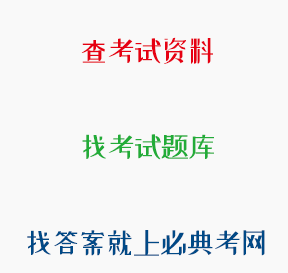正确答案: D
爱岗敬业,乐于奉献
题目:"春蚕到死丝方尽,蜡炬成灰泪始干",体现在教师职业道德规范中,就是()。
解析:《中小学教师职业道德规范》(2008年修订)"爱岗敬业"要求:教师要对工作认真负责,认真上课备课,辅导学生。诗句主要体现的是教师的无私的奉献精神,提现了"爱岗敬业"的职业道德,故选择D选项。
查看原题 查看所有试题
学习资料的答案和解析:
[单选题]20世纪60年代以来,世界上最有影响的教育思潮是( )。
终身教育
解析:终身教育是适应科学知识的加速增长和人的持续发展的要求而逐渐形成的一种教育思想和教育制度,作为当代一种国际性教育思潮,由联合国教科文组织直接倡导和推动,并得到了各国政府的积极响应和合作,在教育理论和实践领域中引起了一场广泛而深刻的革命,必将会改变世界教育的面貌。
[单选题]把学习成就看作是赢得地位和自尊的根源,这是一种( )。
自我提高内驱力
解析:B选项,自我提高内驱力,是个体要求凭自己胜任工作的才能和工作成就而赢得相应地位的愿望。自我提高内驱力把成就看作是赢得地位与自尊心的根源,它显然是一种习俗水平。A选项,认知内驱力,即一种学生渴望了解和理解,要求掌握知识以及系统地阐述问题并解决问题的倾向。这种内驱力,一般说来,多半是从好奇的倾向中派生出来的。C选项,附属内驱力,是学生为了保持家长和教师等的赞许或认可而努力学习的一种需要。它是一种外部的动机。在儿童早期,附属内驱力最为突出,他们努力学习获得学业成就,主要是为了实现家长的期待,并得到家长的赞许。到了儿童后期和少年期,附属内驱力的强度有所减弱,而来自同伴、集体的赞许和认可逐渐替代了对长者的依附。在这期间,赢得同伴的赞许就成为一个强有力的动机因素。而到了青年期,认知内驱力和自我提高的内驱力则成为学生学习的主要动机,学生学习的主要目的在于满足自己的求知需要,并从中获得相应的地位和威望。D选项,无此说法。
[单选题]皮亚杰认为,随着年龄增长,儿童在判断行为对错时,是( )。
从客观责任向主观责任发展
解析:皮亚杰认为,随着年龄的增长,儿童判断行为对错是从客观责任向主观责任发展的。
[多选题]对学生进行思想品德教育是班主任工作的首要任务。( )
解析:班主任工作的首要任务是了解和研究学生。
[单选题]请阅读Passage 1,完成1~5小题。
Passage 1
Today's adults grew up in schools designed to sort us into the various segments of our social and economic system.The amount of time available to learn was fixed: one year per grade.The amount learned by the end of that time was free to vary: some ofus leamed a great deal; some,very little.As we advanced through the grades,those who had learned a great deal in previous grades continued to build on those foundations.Those who had failed to master the early prerequisites within the allotted time failed to learn that which followed.After 12 or 13 years of cumulative treatment of this kinD.we were,in effect,spread along an achievement continuum that was ultimately reflected in each student's rank in class upon graduation.
From the very earliest grades,some students learned a great deal very quickly and consistently scored high on assessments.The emotional effect of this was to help them to see themselves as capable learners,and so these students became increasingly confident in school.That confidence gave them the inner emotional strength to take the risk of striving for more success because they believed that success was within their reach.Driven forward by this optimism,these students continued to try harD.and that effort continued to result in success for them.They became the academic and emotional winners.Notice that the trigger for their emotional strength and their learning success was their perception of their success on formal and informal assessments.
But there were other students who didn't fare so well.They scored very low on tests,beginning in the earliest grades.The emotional effect was to cause them to question their own capabilities as learners.They began to lose confidence,which,in turn,deprived them of the emotional reserves needed to continue to take risks.As their motivation warneD.of course,their performance plummeted.These students embarked on what they believed to be an irreversible slide toward inevitable failure and lost hope.Once again,the emotional trigger for their decision not to try was their perception of their performance on assessments.
Consider the reality-indeed.the paradox-of the schools in which we were reared.If some students worked hard and learned a lot,that was a positive result,and they would finish high in the rank order.But if some students gave up in hopeless failure,that was an acceptable result,too, because they would occupy places very low in the rank order.Their achievement results fed into the implicit mission of schools: the greater the spread of achievement among students,the more it reinforced the rank order.This is why,if some students gave up and stopped trying (even dropped out of school),that was regarded as the student's problem,not the teacher's or the school's.
Once again,please notice who is using test results to decide whether to strive for excellence or give up in hopelessness.The "data-based decision makers" in this process are students themselves.Students are deciding whether success is within or beyond reach,whether the learning is worth the required effort,and so whether to try or not.The critical emotions underpinning the decision making process include anxiety,fear of failure,uncertainty,and unwillingness to take risks-all triggered by students' perceptions of their own capabilities as reflected in assessment results.
Some students responded to the demands of such environments by working hard and learning a great deal.Others controlled their anxiety by giving up and not caring.The result for them is exactly the opposite of the one society wants.Instead of leaving no child behinD.these practices,in effect,drove down the achievement of at least as many students as they successfully elevated.And the evidence suggests that the downside victims are more frequently members of particular socioeconomic and ethnic minorities.
Which of the following will be triggered by the assessment results according to the passage?
Students' learning efforts.
解析:细节题。由倒数第二段可知,根据考试结果决定继续努力还是放弃的是学生自己,在做此决定的过程中的重要情感都是由学生对自己在考试中反映出的能力的态度所决定的。故本题选A。

 川公网安备 51012202001360号
川公网安备 51012202001360号